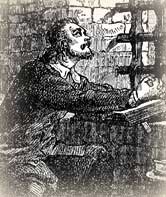By chance - if it were chance - I ended up teaching English in retirement. I tell my students, who feel compelled to hate required English composition, "My friends are on expensive cruises, burning up money. I am on a paid vacation, teaching a fun group of students."
Here and there I also teach graduate school and theology. Fortunately, my theology students are not Lutheran, so they love to hear what Luther says. I quote Luther all the time and teach the close relationship between the Spirit and the Word.
For English class, since my throat was a little sore yesterday - I played the animation of Bunyan's Pilgrim's Progress. I enjoy pointing out that Bunyan's "most read book, after the Bible" was Luther's Galatians Commentary.
https://www.visionvideo.com/detail.taf?_function=detail&a_product_id=31141
Today it is safe to say that Luther's great classic (commended for study in the Book of Concord) is universally ignored.
Pilgrim's Progess is considered the best-selling book in English, after the Bible, but it is almost completely unknown today. When I asked students about the book, a native of Venezuela raised his hand! "I have seen the animation, only in Spanish."
http://www.christianity.com/church/church-history/timeline/1601-1700/bestselling-author-john-bunyan-11630081.html -
Bestselling Author, John Bunyan
Curtis, Lang, Peterson

John Bunyan was born in Elstow, Bedfordshire, England on this day, November 28, 1628. His home was a small thatched cottage, and his father was a tinker, who spent his days pushing a cart along the roads, stopping at homes to fix metal pots and pans.
Young John received a grammar-school education, but like most sons of his day, he learned his father's trade. During the English Civil War he served as a soldier-- probably on the Puritan side. At nineteen he married, and his Christian wife led him to try to reform his life. But John found himself constantly slipping back into old habits. Though he lived well enough to impress his neighbors, he described himself as a "painted hypocrite."
In 1651, John began attending an independent meeting at Bedford and was moved by the pastor's intense biblical preaching. He began to pore over the Scriptures, until the conflict within him ended in the assurance of God's grace in his life. Salvation had come to John Bunyan.
He joined the Bedford congregation and began to preach there, amazing people at the abilities of a "mere" tinker. Though King Charles II had at first promised freedom of religion, increasingly the Anglican church became England's only accepted church. Dissent was not encouraged, and in 1661 the authorities sent John to Bedford jail for his preaching. His times in prison were hard on his family and his blind daughter. He remained there until 1672, when Charles issued the Declaration of Indulgence, extending leniency to non-Anglicans.
Upon his release, the Independent meeting house called him as their pastor. He received a license to preach and became known as Bishop Bunyan-- perhaps becoming the organizing genius of Independents in the area, But the toleration was not to last.
In 1675 Bunyan again found himself in prison, and began his greatest work: The Pilgrim's Progress.This allegory of salvation and the Christian walk has given us such colorful phrases as "Vanity Fair," "the Slough of Despond," "House Beautiful," "Muckraking," and, "Hanging is too good for him." Drawing only on his own experience and the Bible, this largely unlettered preacher created a captivating piece of literature that appeals to those who travel - or would travel - on the spiritual pilgrimage from the City of Destruction to the Celestial City.
Perhaps because so many readers experienced the same sort of pilgrimage in their lives, The Pilgrim's Progress, became the world's best-selling devotional book. Bunyan describes the most intimate states of the Christian soul. His realization of the depth of God's grace in his own life gave Bunyan an ability to speak to many people, even generations, of their own spiritual state. Bunyan's other works, Grace Abounding to the Chief of Sinners, The Life and Death of Mr. Badman, and The Holy War, never achieved the popularity of The Pilgrim's Progress. This one humbly written work touched thousands of live sand became a classic.
Bibliography:
- Adapted from Christian History Institute's book Dates With Destiny by Curtis, Lang and Petersen. Revell, 1991.
- Hendrickson, Ford. Martyrs and Witnesses. Detroit: Protestant Missionary Pub Co., ca. 1917. Source of the image.
- Petersen, William J. C. S. Lewis Had a Wife; Catherine Marshall Had a Husband. Wheaton, Illinois: Tyndale House, 1986.
Last updated July, 2007.

